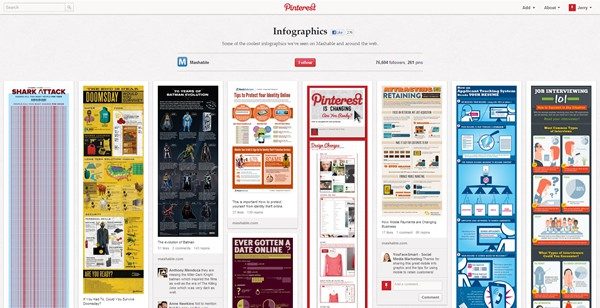- I love
data visualization
- . I love using infographics as part of my web marketing strategies. It’s tough to break through the noise and get a shot at going viral.
But don’t give up just yet. With the right recipe and good marketing skills, infographic is still a good way to draw attention from targeted web audience. In this article, I am going to share five essential tips on how to create and promote infographics effectively.
1. Start With An End In Mind
There are a few questions you need to ask yourself before you start making an infographic.
What is the goal of your infographic?
It is important to define your goals and allow your team (designer, copy writer or yourself) to be clear of what you want to get out of creating an infographic. By doing so, you will be a lot more focused on your campaign.
Who is your target audience?
Just like designing a website, you need to understand your audience. Who is your target audience? Who is most likely to view and share your infographics? Do they really care about what you have to say in your infographic? The better you understand your viewers, the higher chance your infographic goes viral.
Who is supposed to make the infographic?
Should you design your own infographic? If not, who should you hire to get the job done? Honestly, this is one tricky question that I have no fixed answer to.
If you are a graphic designer by profession, then you have Illustrator or Photoshop.
However, if you are like me, who does not know how to operate Adobe Illustrator, Photoshop or ggPlot, things get a little tough. As someone who has spent hundreds of dollars buying copycat work and ugly design from Elance, I knew how hard it is to find a real talent from the freelance market. Personally, I prefer to go with an in-house designer or a reputable design company to avoid headaches. But bear in mind that this means you will need to fork out a great sum for your infographic.
At this time of writing, I am diving into a few WYSIWYG infographic creation tools online, namely Piktochart and Visual.ly. E.g. Piktochart allows you to build your infographic using preset templates and graphics.
As the industry is growing more mature and the tools are getting user-friendly, I believe this will be the cheaper and quicker way to get things done.
How much money are you willing to spend?
Budgeting is the most over-looked issue when it comes to an infographic campaign. Do not spend all your money in production – you should always set aside some for promotional purposes. The last thing you want to do is to spend several weeks making an infographic that no one reads.
2. Research, Research, Research
Ever thought about why ‘info’ comes first in the word ‘infographic’? That is because the information is more important than graphics in infographic 😀 Your infographic will fail if your data is unresearched, self-invented or disorganized, period. Stop picking data from Wikipedia or using misleading “facts”.
There are plenty of ways you can find meaningful data online. For one, your website or blog works perfectly well as a source of meaningful data. Whenever you are running out of data, run a poll and ask your readers opinion on your infographic topic. Secondly, there are plenty of data sources – paid or free – on the Internet. To name a few, here are some of my favorite spots – The Data Hub, Freebase, Data 360, Gallup, and Number Of.
3. Design To Make An Impact
Don’t just make an infographic that looks pretty, design an infographic to make an impact. If you want your infographic to go viral, you will need more than good graphic skills. You will also need good story telling skills and creative copy writing in order to build a rapport with the viewers and make an impact.
4. Fire up Marketing
When the infographic is finally done, it’s time to take out the big guns and fire up your marketing. To get the biggest bang for your infographic, you will need all marketing channels. Here’s what you can do:
Press Release
Though Matt Cutts said it clearly that press release will not help on your SEO campaign, a press release is still a good way to attract traffics and incoming links. You should at least run a round of press release once your work is published.
Optimize Your Infographic For Google Image Search
There are some basic rules to follow in order to rank your infographic well on Google image search. For instance: surround the infographic with your target keywords, use proper alt text, include keywords in your image file name, and make sure the image is available for Google image bots. Piktochart is releasing a search-friendly HTML version.
WordStream.com recently published a very detail article on this topic, in case you wish to learn more, be sure to read How To Drive Google Image Search Traffic.
Email Your Subscribers
If you own an email list, now is the time to feed your subscribers with some beautiful data. Convert your infographic into .pdf format, attach and send it to your email subscribers. Make sure your PDF file size is not too large, make sure you write eye-catching email title, make sure you also include a link to the original post just in case your subscribers want to link to your work from their blogs.
Why .pdf file? Well it’s simply because .pdf file is the easiest file to be shared and read via emails. On top of that, you can also upload the pdf version of your infographic to pdf directories such as Issue and Scribd. Alternatively you can make it in Microsoft Words (.doc) format or use one of the following:
Guest Post With Your Infographic
Write several articles based on the findings in your infographic, get in touch with some of the top bloggers in your industry and ask for a guest post opportunity. If your request is granted, send in your infographic along with your article.
Submit Your Work To Infographic Directories
Some infographic directories will accept and publish your submission for free; some will charge a small fee. As for paid directories, my suggestion is to pick those that are focused on niche that is related to your topic. For example, Money Infographics is a good place to submit your finance related infographic.
Showcase On Pinterest Board
If you have not gotten started on a Pinterest board to showcase your infographics, yesterday was the best day to do so 😉 Some examples of well- organized Pinterest boards:
Roll Out A Series Of Tweets
This is a trick I learned from Neil Patel.
The idea is to drip feed your audience with facts and data extracted from your infographic. Make one tweet for each specific fact from your infographic and roll out a series of Tweets just to promote that one infographic. If your infographic cover 30 facts about tomatoes, then you’ll have 30 tweets, each covering a different fact on tomatoes. http://www.quicksprout.com/2012/06/11/5-ways-to-get-your-infographic-to-go-viral/
Tumblr, Flickr, Imgur
Just like Pinterest and Twitter, you should also upload your infographic to Tumblr, Flickr, and Imgur.
Advertise On StumbleUpon
For start, you can spend $10 – $50 on StumbleUpon – each paid stumble costs only $0.10. The great thing about Stumble Upon is that your marketing campaign on StumbleUpon does not stop when you finish your budget. Your infographic will also receive organic stumbles (which are completely free) if the users like it and share it out with others (which often happens – I once got more than 3,000 organic stumbles in one day, all for the price of $100). In other words, the $50 you spent could bring in ten of thousands of stumbles and shares.
5. Keep The Ball Rolling
That’s right! Don’t just stop at one infographic. Like everything else in life, you will get better at each attempt. If you wish to achieve great goals with your infographics, you will need to rinse and repeat. For those who wish to start things from scratch, you should check out my previous article on How To Make Beautiful Charts and Infographics.
Author Profile
This guest post is written by Jerry Low – a cool dad who has been making a living online for the past 9 years. Jerry writes about web marketing on his new blog at http://www.webrevenue.co, you can also connect with him via Google+ profile.





